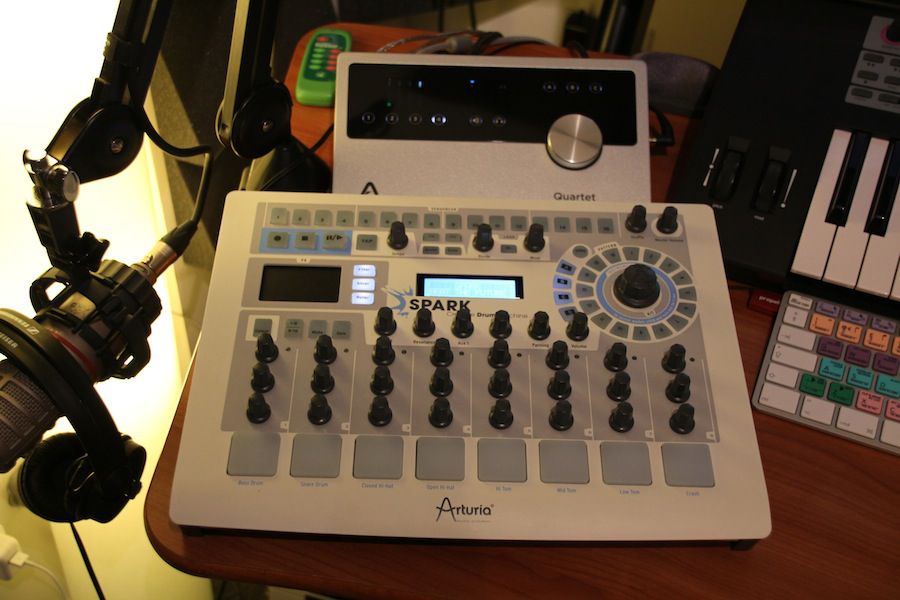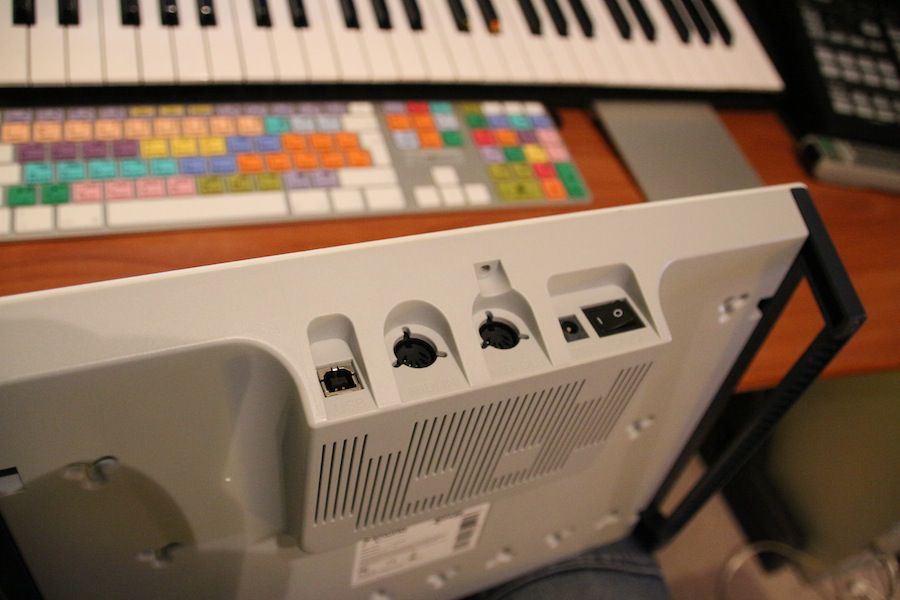I've had my eye on the Arturia Spark for some time now. The friendly people over at Arturia finally sorted a review unit out for me so I have been putting it through its paces over the last few weeks.
On paper, it would appear the Spark is currently one of best hybrid drum based instruments out there. Let's take a look and see how it stands up to current competition...
First Impressions
Aside from the fact that I was sent a pretty heavily fingered unit for the purposes of this review, I was pretty impressed with Spark straight out of the box. It's pretty hard to look past buttons that have popped out due to over use and a battered box but I really do like the way Spark is put together.
Spark arrives in the studio.
The front panel features nicely illuminated rubber buttons, using rather tasteful white LEDs and everything is well spaced out. There has been a trend of late to pack as many controls into tighter and tighter spaces but Arturia appear to have resisted this temptation and given us some space to tweak.
There are some features here you would expect such as a nice bright two line LED display, 8 drum pads and plenty of dedicated (endlessly rotating) knobs. On top of this there are also quite innovate touches. Amongst these are a compact X/Y style touch pad, used for filtering and beat repeat effects, and a ring of illuminated buttons around the main data encoder for selecting the active pattern.
Spark lighting up nicely as I put it into action.
Add all this up and mount it on a matt white metal panel and you have a very nice looking machine that really feels like a solid piece of hardware. There are a few bits of the build that fell slightly short for me but we'll look at those when I sum up later.
Hybrid Heaven
As I mentioned previously, many of the buttons on the Spark hardware are illuminated with white LEDs and there is also a bright LED display. Of course, these aren't the only ways to interact with Spark's inner workings. This is essentially a hybrid system and consists of both the hardware and software components.
As with other similar products the hardware controller is just that, a controller. All the sounds, processing and programming takes place in either a standalone application or plug-in version of Spark. This means you can run it straight from your desktop or in pretty much any major DAW.
The software features three main 'panels', the center panel being the default view and the one that corresponds to the layout of the hardware's interface. On loading the Spark software you are presented with more or less an exact representation of the hardware. This lends a great feeling of cohesion to the whole experience.
This main center section allows you to select patterns, change specific sounds and perform basic alterations. There are actually three knobs above each pad that display key parameters such as decay, snap and pitch. There are also a resonant filter, effect sends and the X/Y pad in this area.
The Spark software's main window is the heart of the system.
Moving to the top section, you'll find a fully fledged step sequencer. I found this to be incredibly well implemented and was programming and editing patterns without any thought. The step sequencer can be used for any of the 16 pad slots and accessed from both the software and hardware. Anything created here will be synced with your DAW and can be exported as either MIDI or audio.
Spark's step sequencer is pretty impressive.
Finally, the lower section deals with all of the mixing, editing and loading of Spark's sounds. Here you can load entire kits from the impressive bundled library. There is everything from real drums to classic drum machines and processed electronica here. Once loaded, you can edit each sound pretty extensively using what seems to be a mixture or synthesis and straight up sample manipulation.
Spark's extensive drum kit/sound library.
The mixer for getting the perfect balance.
There is also a pretty extensive mixer in this section allowing you to mix and route all sixteen separate drum sounds. You can also access the two auxiliary and master effects here. Reverb, delays and compressors are all available to pump up the drum mix.
Effects can be accessed from the mixer section.
Final Thoughts And Conclusion
All in all I have really enjoyed my time with Spark. It's a solid drum production center and gives you just about everything you'll need to produce an entire drum track in or out of your DAW. If you don't need all the bells and whistles that something like NI's Maschine gives you, then you should seriously give Spark a spin.
If you love the feel of the classic drum machine, the tactile approach of hardware, but want access to a huge library of sounds and the ability to map your own sounds to pads and tie all this up with a solid step sequencer, then this really could be what you've been looking for.
I really have found the package useful, it looks great and everyone that's been in the studio has shown genuine excitement about it. Arturia stuff just seems to have this effect on people! For me the real test is how it all sounds and I'm happy to report on the whole it's all very sonically pleasing.
With all the good stuff out of the way I have to say I have a few niggles, nothing show stopping but nonetheless I wanted to air my concerns. My first grievance is related to build quality.
As I've said, on the whole, Spark is very well put together but the supporting 'feet' that run down both sides of the unit seem extremely flimsy to me. They feel too lightweight for such a solid unit and are easily bent. In my opinion these should be constructed from a solid material. Just an opinion and it really may not matter to some.
Spark's 'feet' could be sturdier and let down an otherwise great build quality.
Sparks back panel sports MIDI and a dedicated power switch.
Another minor issue is the responsiveness of the software. I'm on version 1.5 as this is written, and although the whole thing is very stable it does seem a little sluggish in nature. Switching between views and scrolling through the library could be snappier.
Sparks latest V1.5 software.
So as you can see hardly things that would stop you buying Spark, but issues I thought were worth a mention. Overall though, if you are in the market for a hybrid drum production solution, Spark really is one of the best products out there right now. Give it a try for yourself, I'm almost certain you'll love it.
Find out more about Spark at http://www.arturia.com/evolution/en/products/spark/intro.html













 © 2024 Ask.Audio
A NonLinear Educating Company
© 2024 Ask.Audio
A NonLinear Educating Company
Discussion
Want to join the discussion?
Create an account or login to get started!